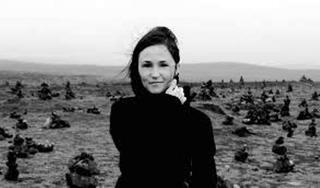|
Back
The Spirits Were Willing... New York
David Geffen Hall, Lincoln Center
04/04/2018 - & April 5, 6, 2018
Anna Thorvaldsdóttir: Metacosmos (World Premiere)
Ludwig van Beethoven: Piano Concerto No. 3 in C Minor, Opus 37 – Symphony No. 3 in E Flat (“Eroica”), Opus 55
Benjamin Grosvenor (Pianist)
New York Philharmonic Orchestra, Esa-Pekka Salonen (Conductor)

A. Thorvaldsdóttir
“I looked on, I thought, I reflected, I admired, in a state of stupefaction not altogether unmingled with fear!”
Jules Verne, on Iceland’s Journey to the Center of the Earth
If all composers partake of their birthplace, Anna Thorvaldsdóttir actually is her native Iceland. Born far from the bright lights of Reykjavik, her tiny town is the gateway to the magical Snæfellsnes peninsula with its myriad of volcanos, with the deep holes which inspired Verne’s Journey to the Center of the Earth, to seal-filled seascapes that seem frozen in antediluvian time.
One inevitably feels that each particle of air carries its own music. And Ms. Thorvaldsdóttir, throughout her entire career, has never altered from creating poems compressing these sounds into huge slow waves of music, hints of ancient dances, long wave of melodies which twist around themselves, and settle into a sort of infinity.
Those images might seem quite pretentious, but after hearing some of Ms. Thorvaldsdóttir ’s work before, I journeyed to Iceland last yearand actually “saw” the notes she has so precisely engendered. In last night’s Metacosmos, she did not disappoint. The opening rumbles were not (as one listener described them) dystopian. They were natural, organic, leading to other instruments passing on their languages to themselves, growing into an ontogeny of creation.
At the height of the orchestral work, she presented a string chorale, a kind of vernal summation of her previous music, then reverting back to the growth. A growth in the Thorvaldsdóttir-Icelandic dream of imaginary trees (Iceland’s original been chopped down by its 14th Century Viking inhabitants) and an unreal un-Biblical genesis.
This was a jewel of a piece, and Ms. Thorvaldsdóttir was there to briefly describe it with conductor Esa-Pekka Salonen.

B. Grosvenor
One had to ask whether Anna Thorvaldsdóttir was the right opener for two major pieces by Beethoven. Yet in a way they complemented each other. Ms. Thorvaldsdóttir does not imitate Nature. She digs into a Hopkins-like inscape of Nature. Nor did Beethoven give a biography of Man in this Third Piano Concerto or Third Symphony. He was straining, certainly in the latter, to reach a kernel of abstract meaning, somehow transforming it into notes. So in a sense, the composers complemented each other.
The Third Concerto was played by 26-year-old Benjamin Grosvenor, and yes, one is quite tired of mentioning the youth of artists like Grosvenor, Trifonov and their colleagues. Mr. Grosvenor was, indeed a wunderkind, has been giving performances for more than a decade, is brilliant, more than accomplished and tripped the keys faultlessly.
Perhaps with the influence of Ms. Thorvaldsdóttir’s ancestors, he opened the Concerto with the thunder of a Valhalla god, and then proceeded to play like controlled lightning. The first movement had accent, verve, musical vitality and those whiplash octaves and trills which are par for the young genius class.
Still, that opening was a bit brittle, Mr. Grosvenor made up for it in the second movement, with a continence and tonal beauty which had escaped the opening., Here he was helped by conductor Salonen, who, in that gorgeous modulation, urged the cellos and bass to a deep yearning power. The pianist finished with a quite jolly finale. Like all the piano concerto finales, these notes were the sparkling wines of the work, and Mr. Grosvenor did sparkle. Perhaps he didn’t add anything singular to the piece, but that was no problem. One was listening to Beethoven, not a showoff pianist.
If Mr. Grosvenor was more accomplished than memorable, the most astonishing–and unexpected–performance was Beethoven’s Eroica. After all (say us blasé and worldly scribes), what can Esa-Pekka Salonen do differently from literally thousands of other conductors? The answer? He is Eka-Pekka Salonen. Thus, it had to be singular.
The conductor didn’t “start” the 3rd Symphony. He plunged into the work and never let it go. Instead of tragic masterpiece composed on the cusp of Classical and Romantic. Mr. Salonen conducted it like a musical adventure, never stopping for a moment, never even giving us a chance to savor those oh-so-passionate measures.
Rather than repeating the exposition, he conducted the first movement as if he was afraid his New York Philharmonic might backtrack, or give us breathing space. There was no reason to repeat material we’d already heard. With strings and timpani ringing, he rarely paused for us to relish the grand climaxes. Instead, he seemed to think that those notes speak for themselves.
Just as Mr. Salonen had to unfree himself from his Sibelius heritage (though conducting some marvelous Sibelius) he also released himself from the depths of the “Funeral March.” Grandiose rhetoric be damned. Rather than letting us wade through the fugue, tasting all its emotional depth, he offered a movement which flew rather than soared.
One hates to say that the third movement was Haydnesque. But yes, he whipped through this Allegro vivace with delight rather than fury. And all those horns in the Trio were faultless this first night.
Mr. Salonen didn’t need to speed up his tempos at any point. Rather, he gave us a lightweight, perhaps an 18th Century “Eroica”. These were 21st Century orchestral huge orchestral forces, to be sure, but he “played” them as if there were a string quartet.
That was most full in the finale variations. I have heard them more powerfully, more dazzling, but never have I heard such contrapuntal transparency. We could have been listening to the finale of Mozart’s 41st Symphony, save for the conductor giving us Beethoven’s finale in all its unalloyed grandeur.
A long time ago, I interviewed a great British actor sitting by the river at Bangkok’s Oriental Hotel. He had just played Hamlet in London, and I asked how it was possible to play a different Denmark prince after all these years.
He pointed to the river and the sky. “Tell me,” he said, “is any sunset over the Chao Phrya River the ‘best’ sunset? Hell, no, not one is anything like any other one.”
Maestro Salonen proved that last night. Nobody who heard it will ever say, “What do you do with another Eroica”? Mr. Salonen’s Beethoven was unique and unforgettable.
Harry Rolnick
|